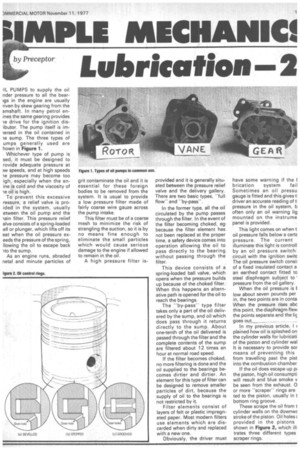MPLE MECHANIC Lubrication
Page 139

If you've noticed an error in this article please click here to report it so we can fix it.
by Preceptor
IL PUMPS to supply the oil nder pressure to all the bearigs in the engine are usually riven by skew gearing from the amshaft. In many petrol enines the same gearing provides le drive for the ignition dislbutor. The pump itself is imlersed in the oil contained in le sump. The three types of umps generally used are hown in Figure 1.
Whichever type of pump is sed, it must be designed to rovide adequate pressure at )vv speeds, and at high speeds le pressure may become too igh, especially when the enme is is cold and the viscosity of le oil is high.
To prevent this excessive ressure, a relief valve is proided in the system, usually etween the oil pump and the lain filter. This pressure relief alve consists of a spring-loaded all or plunger, which lifts off its eat when the oil pressure exeeds the pressure of the spring, 'lowing the oil to escape back ito the sump.
As an engine runs, abraded netal and minute particles of grit contaminate the oil and it is essential for these foreign bodies to be removed from the system. It is usual to provide a low pressure filter made of fairly coarse wire gauze across the pump intake.
This filter must be of a coarse mesh to minimize the risk of strangling the suction, so it is by no means fine enough to eliminate the small particles which would cause serious damage to the engine if allowed to remain in the oil.
A high pressure filter is provided and it is generally situated between the pressure relief valve and the delivery gallery. There are two basic types, "full flow' and "by-pass".
In the former type, all the oil circulated by the pump passes through the filter. In the event of the filter becoming choked, eg because the filter element has not been replaced at the proper time, a safety device comes into operation allowing the oil to pass directly to the bearing without passing through the filter.
This device consists of a spring-loaded ball valve, which opens when the pressure builds up because of the choked filter. When this happens an alternative path is opened for the oil to reach the bearings.
The "by-pass" type filter takes only a part of the oil delivered by the sump, and oil which does pass through it returns directly to the sump. About one-tenth of the oil delivered is passed through the filter and the complete contents of the sump are filtered about 12 times an hour at normal road speed.
If the filter becomes choked, no more filtering is done and the oil supplied to the bearings becomes dirtier and dirtier. An element for this type of filter can be designed to remove smaller particles of dirt, because the .supply of oil to the bearings is not restricted by it.
Filter elements consist of layers of felt or plastic impregnated paper. Most modern filters use elements which are discarded when dirty and replaced with a new one, Obviously, the driver must have some warning if the I brication system fail Sometimes an oil pressu gauge is fitted and this gives II driver an accurate reading of t! pressure in the oil system, b often only an oil warning lig mounted on the instrume panel is provided.
This light comes on when t oil pressure falls below a certz' pressure. The current illuminate this light is controll by an oil pressure switch circuit with the ignition switc The oil pressure switch consii of a fixed insulated contact a an earthed contact fitted to steel diaphragm subject to ' pressure from the oil gallery.
When the oil pressure is k low about seven pounds per in, the two points are in conta When the pressure rises abc this point, the diaphragm flex the points separate and the li goes out.
In my previous article, I plained how oil is splashed on the cylinder walls for lubricati of the piston and cylinder wal It is necessary to provide sor means of preventing this from travelling past the pist into the combustion chamber If the oil does escape up pi the piston, high oil consumpti will result and blue smoke v be seen from the exhaust. 0 or more "scraper" rings are ted to the piston, usually in t bottom ring groove.
These scrape the oil from t cylinder walls on the downw stroke of the piston. Oil holes provided in the pistons shown in Figure 2, which ill' trates three different types scraper rings.
















































































































































































































































